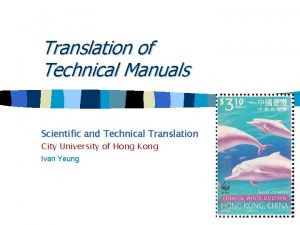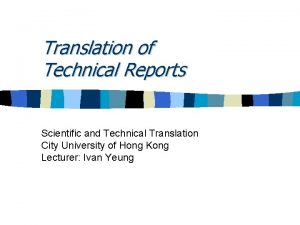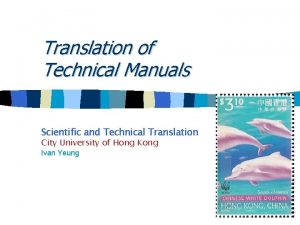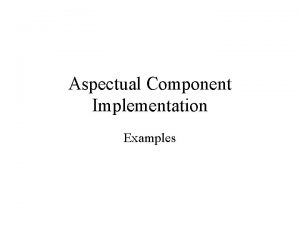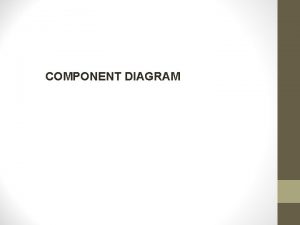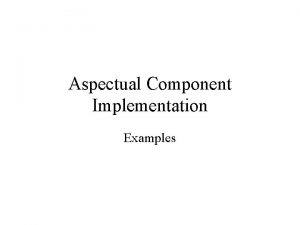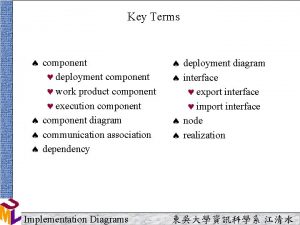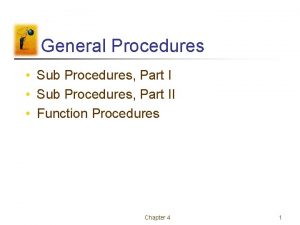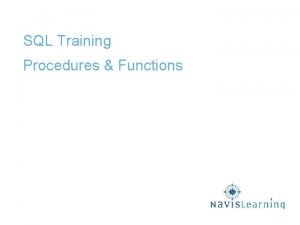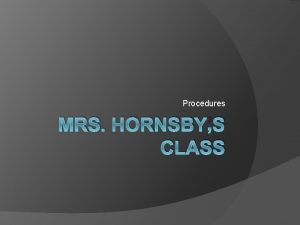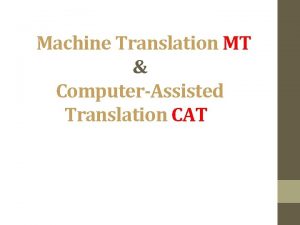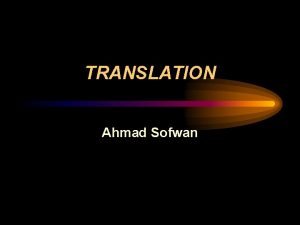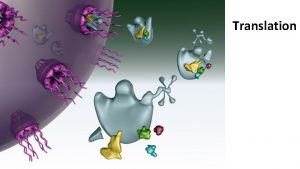Translation Procedures The technical Component of the Translation



































- Slides: 35

Translation Procedures: The technical Component of the Translation Process Presentation by Dr. ANGELO PIZZUTO

The process of translating Translation, as perceived in this workshop, is a process during which the translator: a) makes a number of decisions on how to interpret the source text (ST); b) uses resources and apply technical skills to render the text in the target language; and c) re-expresses that meaning in the target text (TT); i. e. the translation. Therefore, translation is perceived as a problem-solving process.

Skills needed in translation In popular belief, to translate, a person only needs: • Reasonable knowledge of a foreign language • And a few good dictionaries For some, translating is an intuitive process that is based on the translator’s creative capability. On the opposite extreme, there are those who believe that only specialists like lawyers or scientists can translate. Those who make these assertions fail to make a distinction between factual knowledge and procedural knowledge.

Distinguishing Factual Knowledge and Procedural Knowledge Factual knowledge is the knowledge of special fields Special terminology Resources available Foreign languages Factual knowledge is essential but not enough. Translators also need procedural knowledge. Procedural knowledge relates to some kind of method or procedure to help the translator in seizing the meaning of the ST and re-expressing that meaning in the TT.

Procedural Knowledge: Options for translation Basically, a translator has two options for translating: 1. Direct or literal translation 1. Oblique translation There are several translation techniques available under each option.

Procedural Knowledge: Options for translation 1. Direct or literal translation 2. Oblique translation Are these approaches applicable to the translation of legal texts?

Direct translation Possible because of parallel categories 1. Structural parallelism → grammatical categories Are you there? → Voi siete qui ? 2. Meta-linguistic parallelism → parallel concepts The book → il libro The judge → il giudice

Oblique translation There comes a time when direct translation techniques would not work because: 1. They are structurally impossible 2. The target language does not have a corresponding expression And the generated text would have: 1. a different meaning 2. no meaning 3. a foreign structure

Oblique translation Compare: He looked at the map. → Lui ha guardato la mappa He looked the picture of health. → Era l’immagine della salute. (Back-translation: He was the image of health itself. ) (Back-translation: He was the image of health itself. He seemed in good shape. ) I have a headache → Mi duole la testa I → mi Have → duole (verb) Headache → mal di testa Both English and italian have the corresponding elements But the structure of the statement is different in the two languages. A direct translation is no longer possible. The translator needs to use oblique translation techniques.

DIRECT TRANSLATION TECHNIQUES 1. Borrowing It is used: To overcome a gap or lacuna (a new technical process, a new concept) → Dumping (trade law). There is no equivalent in Italian Create stylistic effect → chic, déjà vu To recreate the flavor of the source language (SL) → Margaritas, tortillas, Pisco sour, sushi, sauerkraut, spaghetti, In the legal field, Latin expressions* are an excellent example of borrowing that have been made through time. Prima facie, nolo contendere, pro se. Generally, borrowings enter a language through translation, and just as with false friends (false cognates) the translator should strive to look for the equivalents in the SL that convey the meaning of the SL more advantageously. *A great number of Latin expressions have evolved differently in the various languages. Beware of spelling, among other things.

DIRECT TRANSLATION TECHNIQUES 2. Calque (From the French verb "calquer") Calques are special kind of borrowing where a language borrows a word or an expression from another language and translates literally each of its elements. Lexical calque Football → Fútbol → Balompié 4 X 4 → cuatro por cuatro (4 X 4) Structural calque Your are intelligent enough to realize that… → (Back-translation → Your are intelligent and can realize that…)

DIRECT TRANSLATION TECHNIQUES Both borrowing and calque may become lexicalized (fixed) in the TL over time. Science fiction → ciencia ficción; Carburator → r Menu → menú In the legal field, structural calque oftentimes arises from oversight of the morpho-syntactic structure of both SL and TL. As used in this section, "serious violent felon" means a person who has been convicted of: attempting to commit or conspiring to commit a serious violent felony (Back translation → Attempting to commit a serious violent felony or conspiring to do do. )

DIRECT TRANSLATION TECHNIQUES 3. Literal translation refers to a translation technique that can be used when the languages involved share parallel structures and concepts; NOT to a translation made word for word: Literal translation carries the imprint of the original. This technique is used when it is possible to transpose the source language (SL) message element by element into the target language (TL) and obtain a text that is idiomatic. The girl is sick → la bambina sta male How are you? → come stai? Good morning → buon giorno? Spanish syntax requires that we add ¨s¨ to both words, but this continues to be literal translation. It is just a case of syntax normalization.

OBLIQUE TRANSLATION TECHNIQUES 4. Transposition is the first technique or step towards oblique translation. • Operates at the grammatical level • Consists of the replacement of a word class by another word class without changing the meaning Within the same language: Reconstruction of the city is very important Reconstructing the city is very important To reconstruct the city is very important (Back-translation: I don’t care about your anger. I don’t care about your getting angry. )

OBLIQUE TRANSLATION TECHNIQUES Public servants should be held accountable for their management of public goods. → The use of the pronominal passive allows a rendition that does not indicate the subject of the sentence, like in the ST. From a stylistic view point the transposed expression does not have the same value, but the meaning is the same. Transposed expressions are generally more literary in character. It is important to choose the form that best fits the context.

OBLIQUE TRANSLATION TECHNIQUES Transposition can be: Free: When the transposition used depends mostly on context and desired effect. The course is of interest to all of us. (Back-translation: The course interests all of us) Compulsory: When only a transposition is acceptable. I will never forget the time when I got lost in the market. (Backtranslation: I will never forget the time that I got lost in the market. ) When (adverb) → quando (relative pronoun)

OBLIQUE TRANSLATION TECHNIQUES Types of transposition Adverb→ verb I only defended myself. (Back-translation → I did nothing but defend myself. ) Adverb→ noun I wrote to you early this year. (Back-translation → I wrote to you at the beginning of the year) Adverb→ adjective He lives precariously (Back-translation → He leads a precarious life)

OBLIQUE TRANSLATION TECHNIQUES Types of transposition Adjective→ noun He found it difficult to arrange for the trip (Back-translation → I had difficulty to make the arrangemets for the trip) Possessive adjective → definite article Your hair is too long→ (Back-translation → Your have the hair too long) Verb or past participle → noun I intended to tell you the whole truth. (Back-translation → My intention was to tell you the whole truth. ) Adverb → noun I wrote to you early this year. → (Back-translation → wrote to you at the beginnig of the year. )

OBLIQUE TRANSLATION TECHNIQUES 5. Modulation A variation of the form of the message obtained by a change in the point of view. Although the main characteristic of modulation is a change of point of view, it may involve also a change of grammatical categories. It is used when the other techniques would generate a text that is grammatically correct, but unsuitable, not idiomatic, or awkward.

OBLIQUE TRANSLATION TECHNIQUES Modulation can be: Free It is not difficult to show (Back-translation → it is easy to show) Remember → (if it fits the context better) (Back-translation → Remember; do not forget) Lexicalized (fixed by use, listed in dictionaries) or Compulsory Dress rehearsal (Back-translation → General rehearsal)

OBLIQUE TRANSLATION TECHNIQUES Modulation is a technique that experienced translators use to produce an accurate and idiomatic text. It requires an excellent knowledge of both languages involved in the translation. This includes knowing the mechanics of the language. For example: 1. The manner in which negative and positive formulations are used in the two languages. Do not enter. →Vietato entrare 2. The general register of the language. For example italians tend to use more “intellectual” terms than English. Eye doctor → oculista; bird watching → ornitología; dog show → esposizione canina 3. Use of the passive voice. 4. The greater the structural difference between the two languages the greater the challenges for the translator

OBLIQUE TRANSLATION TECHNIQUES Types of modulation Most of the types are based on metonymy: e. g. referring to a concept by an attribute of it. For example; “the crown” referring to a monarch or “Washington” to refer to the United States government. 1. Abstract → Concrete or General → Particular I haven’t heard a word from him → Non ho avuto sue notizie (Back-translation: I have not had news from him. )

OBLIQUE TRANSLATION TECHNIQUES 2. Explanatory modulation: cause → effect Like a deer in the headlights. →fermarsi paralizzato (Back-translation: remain paralyzed) Blind flying → volare senza visibilità (Back-translation: flight without visibility) means → result, or viceversa I’ll drive you home → Ti accompagno a casa in auto (Back-translation: I’ll take you to your house in [my] car) substance → object Brain drain → Fuga di cervelli (double modulation) (Back-translation: the exodus of experts)

OBLIQUE TRANSLATION TECHNIQUES 2. Explanatory modulation (continued): A part → the whole The cathedral’s ceiling draws the eye as soon as one enters. (Back-translation: The cathedral’s ceiling draws the view. ) A part → another part I know the city like the back of my hand. Conosco la città come le mie tasche (Back-translation: I know the city like the palm of my hand. ) Hand to hand combat→ Combattere corpo a corpo; (Back-translation: body to body combat. )

OBLIQUE TRANSLATION TECHNIQUES 2. Explanatory modulation (continued): Term reversal This cage cannot hold an animal this size. → Questa gabbia non mantiene animali did questa grandezza (Backtranslation: An animal this size will not fit in this cage. ) Negative contrast Make sure you call us every week. → Non dimenticatre did chiamare ogni settimana (Back-translation: Don’t forget to call us all of the weeks. ) Active voice → passive voice (and vice-versa) The votes (in an election) were counted. → I voti sono stati conteggiati (impersonal form)

OBLIQUE TRANSLATION TECHNIQUES 2. Explanatory modulation (continued): Space → Time In grammar school I was very shy. → (Back-translation: When I was attending elementary school. ) Intervals and boundaries (in time and space) A. In time: See you in a week → (Back-translation: We’ll see each other in eight days from today. ) B. In space: No parking between signs → (Back-translation: Limit of parking. ) Change of symbol He earns an honest dollar. (Back-translation: He earns an honest living. )

OBLIQUE TRANSLATION TECHNIQUES Sensory modulation A heavy coat → una giacca pesante (Back-translation: A thick coat) A goldfish → un pesce rosso (Back translation: a little red fish) In short, modulation is the technique that leads to a solution that makes the reader - or the translator – exclaim, “Yes, that’s exactly what you would say. ”

OBLIQUE TRANSLATION TECHNIQUES 6. Equivalence Used to render expressions using different stylistic and structural methods. Most equivalences are fixed, and include idioms, clichés, proverbs, nominal or adjectival phrases, onomatopoeia, etc. Stop splitting hairs → Non guardare il pelo nell’uovo (Backtranslation: Stop looking for five legs in a cat) Challenge: To recognize that the expression to be translated is an idiom / proverb; to know the equivalent expression in the T. L. Equivalence also refers to fixed (lexicalized) terms, such as terminology of a field of knowledge.

OBLIQUE TRANSLATION TECHNIQUES 7. Adaptation Used when the limit to translation is been reached, i. e. when a simple translation would not work or it would produce a result that is shocking in the target language and culture. Titles of books, movies, and characters often fit into this category Butch Cassidy and the Sundance Kid → (Back-translation: Two men and a destiny) The Sound of Music (Back-translation: Smiles and tears)

Other taxonomies (categorizations) of translation techniques 1. Concretization or differentiation→ generalization (Fawcett) Abstract → Concrete or General → Particular modulation Fratelli e sorelle → brothers and sister, siblings (depending on context and desired effect) 2. Paraphrasing Used when there is no equivalent in the target language Paraphrasing is a type of explanatory modulation To perform hazing [a crime] → efectuar o someter a actos iniciáticos ilícitos (hazing) (Back-translation: to subject to unlawful initiation acts)

Other taxonomies (categorizations) of translation techniques 2. Paraphrasing Translation does not mean explaining or commenting on a text, or writing it in our own way. “Paraphrasing, according to Vásquez-Ayora, ´cannot be a translation method because using it the text loses its characteristics. Too many explanations destroys the conciseness of the work and makes it subject to the same distortions of its counterpart – literal translation. ´”

Other taxonomies (categorizations) of translation techniques 3. Logical derivation Cause → effect modulation (logical modulation, according to Fawcett) Shorter [fewer] working hours (hours have become fewer as a result of some action taken) (Back-translation: reduction in working time / working week)

Direct or literal translation techniques: p Borrowings: borrowing from the source language a term or concept to overcome a lacuna in the target language or to create a stylistic effect. SUSHI, SAUERKRAUT, PIZZA p Calque: a special type of borrowing, consisting of borrowing an expression from the source language and translating literally each element. Calque can be either lexical. CARBURATOR → or structural MAYO 5, INSTEAD OF 5 DE MAYO p Literal translation: the direct transfer of the source text into the target language in a grammatically and idiomatically proper way. GOOD MORNING

Oblique translation techniques: p p Transposition: replacing words from one grammatical word class with another without changing the meaning of the message. RECONSTRUCTION OF THE CITY IS VERY IMPORTANT RECONSTRUCTING THE CITY IS VERY IMPORTANT, TO RECONSTRUCT THE CITY IS VERY IMPORTANT Modulation: changing the point of view without changing the meaning of the message. (Vinay and Darbelnet identified 10 different types of modulation. IT IS NOT DIFFICULT → IT IS EASY Equivalence: generally refers to the commonly accepted and used equivalents of idioms, proverbs, idiomatic expression and lexicalized terms, i. e. terms commonly accepted as equivalents of a source language term. STOP SPLITTING HAIRS → DEJA DE BUSCARLE CINCO PATAS AL GATO. BACK TRANSLATION: STOP LOOKING FOR FIVE LEGS IN A CAT. Adaptation: adapting a source language situation when it does not exist in the target language or would be considered inappropriate in the target culture. THE SOUND OF MUSIC → SONRISAS Y LÁGRIMAS BACK-TRANSLATION: SMILES AND TEARS

REFERENCES p FAWCETT, Peter (1997). Translation and Language, Manchester, UK: St Jerome. p Sager, Juan C and M. -J. Hamel (tranls) (2000). Jean-Paul Vinay and Jean Darbelnet. A Method for Translation, in Lawrence Venuti (ed. ) The Translation Studies Reader, London: Routledge: 85 -93. p Vazquez-Ayora Gerardo (1977). Introducción a la traductología, Washington, D. C. : Georgetown University. p VINAY, J. P. et J. Darbelnet (1958). Stylistique comparée du français et de l’anglais, Montréal: Beauchemin
 Cisco voice translation rule
Cisco voice translation rule Linear function transformations
Linear function transformations Semantic translation và communicative translation
Semantic translation và communicative translation Semantic model of translation
Semantic model of translation Gấu đi như thế nào
Gấu đi như thế nào Thẻ vin
Thẻ vin V cc
V cc Thể thơ truyền thống
Thể thơ truyền thống Sự nuôi và dạy con của hổ
Sự nuôi và dạy con của hổ Thế nào là hệ số cao nhất
Thế nào là hệ số cao nhất Diễn thế sinh thái là
Diễn thế sinh thái là Vẽ hình chiếu vuông góc của vật thể sau
Vẽ hình chiếu vuông góc của vật thể sau Lp html
Lp html Phép trừ bù
Phép trừ bù Lời thề hippocrates
Lời thề hippocrates Vẽ hình chiếu đứng bằng cạnh của vật thể
Vẽ hình chiếu đứng bằng cạnh của vật thể Thang điểm glasgow
Thang điểm glasgow đại từ thay thế
đại từ thay thế Quá trình desamine hóa có thể tạo ra
Quá trình desamine hóa có thể tạo ra Khi nào hổ mẹ dạy hổ con săn mồi
Khi nào hổ mẹ dạy hổ con săn mồi Thế nào là mạng điện lắp đặt kiểu nổi
Thế nào là mạng điện lắp đặt kiểu nổi Các loại đột biến cấu trúc nhiễm sắc thể
Các loại đột biến cấu trúc nhiễm sắc thể Các châu lục và đại dương trên thế giới
Các châu lục và đại dương trên thế giới Bổ thể
Bổ thể Thế nào là sự mỏi cơ
Thế nào là sự mỏi cơ độ dài liên kết
độ dài liên kết Thiếu nhi thế giới liên hoan
Thiếu nhi thế giới liên hoan Tia chieu sa te
Tia chieu sa te Chúa sống lại
Chúa sống lại điện thế nghỉ
điện thế nghỉ Một số thể thơ truyền thống
Một số thể thơ truyền thống Trời xanh đây là của chúng ta thể thơ
Trời xanh đây là của chúng ta thể thơ Hệ hô hấp
Hệ hô hấp Cong thức tính động năng
Cong thức tính động năng Bảng số nguyên tố lớn hơn 1000
Bảng số nguyên tố lớn hơn 1000 Tỉ lệ cơ thể trẻ em
Tỉ lệ cơ thể trẻ em





































